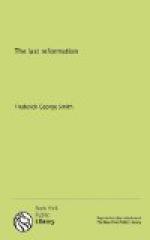Protestant commentators generally apply both the ten-horned beast and the two-horned beast to Rome, the first representing the political power, and the second the ecclesiastical power. But this position, while clearing Protestantism of any moral stigma, is such a manifest violation of the laws of symbolic language and the general principles of Scriptural interpretation that I marvel that any critical thinker could decide to adopt it. The two beasts are especially distinguished, and in each case the symbol is complete. The first beast combines with its beastly characteristics the qualities of the human, as did the little horn of Daniel 7, thus clearly and positively representing both the political and the ecclesiastical dominion of Rome. It is the human characteristics that constitute the leading feature of the terrible work ascribed to the first beast; therefore, the papacy as a religious power is particularly intended. Hence the second beast can not be intended to represent the ecclesiastical phase of Rome. Notice, also, that the symbol of the second beast is likewise complete in itself—animal and human—thus embracing both the political and the ecclesiastical. Another system totally distinct from the first is therefore represented.
I call attention to certain distinct points proving that these two beasts are not identical or simultaneous:
1. The first is spoken of as “a beast”; the second is called “another beast.”
2. The first came up from the sea; the second came out of the earth.
3. The first was like a leopard; the second was like a lamb.
4. The first had ten horns signifying ten temporal kingdoms; the second had two horns, referring to but two temporal powers that supported it.
5. The first blasphemed God and his tabernacle, and was therefore antichrist; the second claimed to be the true prophet of God and brought down “fire from heaven” to attest his claim, but he was in reality a “false prophet” (chap. 16:13; 19:20).
6. The first obtained his power and authority from the dragon which preceded him; while the second derived his power from the ten-horned beast “before him.”
7. The first caused people to worship the preceding power styled “the dragon”; while the second caused people to “worship the first beast.”
8. The first was to continue 1,260 years; while the reign of the second is not here stated, but is covered in a parallel prophecy to which we shall refer later.
The first beast came up out of the sea, which signifies the empire in an agitated state; and it is a fact of history that the ten kingdoms came up through great political convulsions. The empire was in a state of comparative quiet, however, when the second beast “came up out of the earth.” This beast stands as the symbol of Protestantism in Europe, although his power and influence was afterwards to extend to “the whole world” (chap. 16:14). But this beast existed first on the same territory occupied by the papacy; therefore the two horns doubtless signify temporal kingdoms also, and two of the original ten. The two nations first to turn violently against the papacy and to become the chief supporters and defenders of Protestantism were Germany and England.




